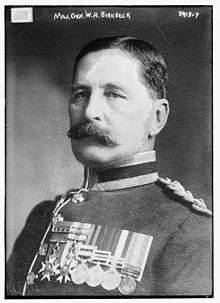William Henry Birkbeck
| Sir William Birkbeck KCB CMG | |
|---|---|
 Birkbeck in 1916 | |
| Birth name | William Henry Birkbeck |
| Born |
8 April 1863 Settle, North Yorkshire, England |
| Died |
16 April 1929 (aged 66) Saint-Briac-sur-Mer, France |
| Allegiance |
|
| Service/branch |
|
| Years of service | 1883–1929 |
| Rank | Major-General |
| Battles/wars |
South African War First World War |
Major-General Sir William Henry Birkbeck KCB CMG (8 April 1863 – 16 April 1929) was a British Army officer and administrator. He served in the South African War and First World War, and was the director of remounts at British Army Headquarters from 1912 to 1920.[1]
Early life and education
Birkbeek was born on 8 April 1863 in Settle, North Yorkshire in England to banker Joseph Birkbeck and Mary Elizabeth (née Mackesy). He was educated at Summer Fields School and Wellington College, where he was on the cricket team. He then entered the Royal Military College, Sandhurst.[1]
Career
In 1883, Birkbeek was commissioned as a Lieutenant in the 1st King's Dragoon Guards, then sent to India. He served in the Hazara Expedition of 1888 and Chin Lushai Expedition of 1889-90 as a signalling officer. He was mentioned in despatches and received the campaign medal and two clasps.[1]
He became aide-de-camp to Major-General Henry Clement Wilkinson CB , commanding the North-Eastern District at York, while he prepared for entrance to Staff College, Camberley. He was in the famous 1896-97 class at Staff College that included Douglas Haig, 1st Earl Haig and Edmund Allenby, 1st Viscount Allenby, and many other officers who distinguished themselves in the South African War and First World War.[1]
Birkbeek served throughout the South African War as assistant Inspector of Remounts and was promoted to brevet lieutenant-colonel. He impressed his superiors; Field Marshall Herbert Kitchener referred to him in a despatch as "imperturbable."[1]
Following the war, he served with the War Office for two year as a Staff officer with military education and training under Field-Marshal Sir Henry Wilson, who became one of his closest friends. In 1905, he was posted for a year with the Japanese Army in Manchuria, "where his immense size and genial nature made an excellent impression on our Allies, and led them to help him with much valuable information for his reports."[1]
After returning home, he spent several years as commander of the Cavalry School, on Netheravon. In 1912, he returned to the remount service, and served as its director with the War Office from 1912 to 1920.[1]
Personal life
In 1905, he married American Mabel (née Shaw), of New Brighton, Staten Island. They had three sons.[1]
In 1915, he suffered a fall from his horse and was injured, and never fully recovered. He died after a fall while hiking at St. Briac, near Dinard in France in 1929.[1][2]
Honours
- 1902 – Companion of the Order of the Bath[3]
- 1906 – Companion of the Order of St Michael and St George[4]
- 1915 – Knight Commander of the Order of the Bath[5]
- 1917 – Commander of the Order of the Crown[6]
- 1917 – Commander of the Legion of Honour[7]
References
- 1 2 3 4 5 6 7 8 9 "Major-General Sir W. H. Birkbeck – Organizer and Administrator". The Times. The Times Digital Archive. 18 April 1929. p. 21.
- ↑ "General Sir W. Birkbeck Dead". Brisbane Courier. 19 April 1929. Retrieved 2015-03-19.
- ↑ The Edinburgh Gazette: no. 11458. p. 1085. 4 November 1902.
- ↑ The London Gazette: no. 27895. p. 1881. 16 March 1906.
- ↑ The London Gazette: (Supplement) no. 29180. p. 5326. 1 June 1915.
- ↑ The London Gazette: (Supplement) no. 30202. p. 7591. 24 July 1917.
- ↑ The London Gazette: (Supplement) no. 30306. p. 9946. 25 September 1917.